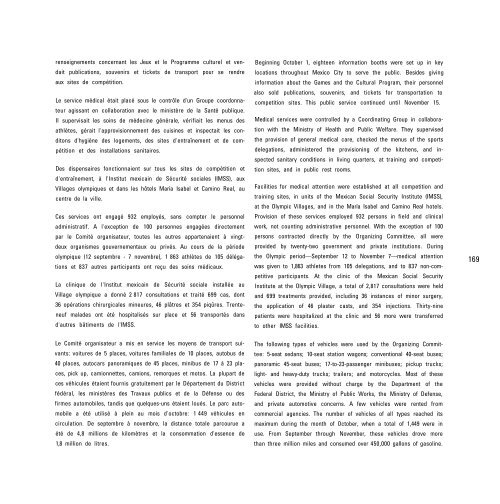Mexico City Olympic Games Official Report ... - LA84 Foundation
Mexico City Olympic Games Official Report ... - LA84 Foundation
Mexico City Olympic Games Official Report ... - LA84 Foundation
Create successful ePaper yourself
Turn your PDF publications into a flip-book with our unique Google optimized e-Paper software.
enseignements concernant les Jeux et le Programme culturel et ven-<br />
dait publications, souvenirs et tickets de transport pour se rendre<br />
aux sites de compétition.<br />
Le service médical était placé sous le contrôle d'un Groupe coordonna-<br />
teur agissant en collaboration avec le ministère de la Santé publique.<br />
Il supervisait les soins de médecine générale, vérifiait les menus des<br />
athlètes, gérait l'approvisionnement des cuisines et inspectait les con-<br />
ditons d'hygiène des logements, des sites d'entraînement et de com-<br />
pétition et des installations sanitaires.<br />
Des dispensaires fonctionnaient sur tous les sites de compétition et<br />
d'entraînement, à l'Institut mexicain de Sécurité sociales (IMSS), aux<br />
Villages olympiques et dans les hôtels María Isabel et Camino Real, au<br />
centre de la ville.<br />
Ces services ont engagé 932 employés, sans compter le personnel<br />
administratif. A l'exception de 100 personnes engagées directement<br />
par le Comité organisateur, toutes les autres appartenaient à vingt-<br />
deux organismes gouvernementaux ou privés. Au cours de la période<br />
olympique (12 septembre - 7 novembre), 1 863 athlètes de 105 déléga-<br />
tions et 837 autres participants ont reçu des soins médicaux.<br />
La clinique de l'Institut mexicain de Sécurité sociale installée au<br />
Village olympique a donné 2 817 consultations et traité 699 cas, dont<br />
36 opérations chirurgicales mineures, 46 plâtres et 354 piqûres. Trente-<br />
neuf malades ont été hospitalisés sur place et 56 transportés dans<br />
d'autres bâtiments de l'IMSS.<br />
Le Comité organisateur a mis en service les moyens de transport sui-<br />
vants: voitures de 5 places, voitures familiales de 10 places, autobus de<br />
40 places, autocars panoramiques de 45 places, minibus de 17 à 23 pla-<br />
ces, pick up, camionnettes, camions, remorques et motos. La plupart de<br />
ces véhicules étaient fournis gratuitement par le Département du District<br />
fédéral, les ministères des Travaux publics et de la Défense ou des<br />
firmes automobiles, tandis que quelques-uns étaient loués. Le parc auto-<br />
mobile a été utilisé à plein au mois d'octobre: 1 449 véhicules en<br />
circulation. De septembre à novembre, la distance totale parcourue a<br />
été de 4,8 millions de kilomètres et la consommation d'essence de<br />
1,8 million de litres.<br />
Beginning October 1, eighteen information booths were set up in key<br />
locations throughout <strong>Mexico</strong> <strong>City</strong> to serve the public. Besides giving<br />
information about the <strong>Games</strong> and the Cultural Program, their personnel<br />
also sold publications, souvenirs, and tickets for transportation to<br />
competition sites. This public service continued until November 15.<br />
Medical services were controlled by a Coordinating Group in collabora-<br />
tion with the Ministry of Health and Public Welfare. They supervised<br />
the provision of general medical care, checked the menus of the sports<br />
delegations, administered the provisioning of the kitchens, and in-<br />
spected sanitary conditions in living quarters, at training and competi-<br />
tion sites, and in public rest rooms.<br />
Facilities for medical attention were established at all competition and<br />
training sites, in units of the Mexican Social Security Institute (IMSS),<br />
at the <strong>Olympic</strong> Villages, and in the María Isabel and Camino Real hotels.<br />
Provision of these services employed 932 persons in field and clinical<br />
work, not counting administrative personnel. With the exception of 100<br />
persons contracted directly by the Organizing Committee, all were<br />
provided by twenty-two government and private institutions. During<br />
the <strong>Olympic</strong> period—September 12 to November 7—medical attention<br />
was given to 1,863 athletes from 105 delegations, and to 837 non-com-<br />
petitive participants. At the clinic of the Mexican Social Security<br />
Institute at the <strong>Olympic</strong> Village, a total of 2,817 consultations were held<br />
and 699 treatments provided, including 36 instances of minor surgery,<br />
the application of 46 plaster casts, and 354 injections. Thirty-nine<br />
patients were hospitalized at the clinic and 56 more were transferred<br />
to other IMSS facilities.<br />
The following types of vehicles were used by the Organizing Commit-<br />
tee: 5-seat sedans; 10-seat station wagons; conventional 40-seat buses;<br />
panoramic 45-seat buses; 17-to-23-passenger minibuses; pickup trucks;<br />
light- and heavy-duty trucks; trailers; and motorcycles. Most of these<br />
vehicles were provided without charge by the Department of the<br />
Federal District, the Ministry of Public Works, the Ministry of Defense,<br />
and private automotive concerns. A few vehicles were rented from<br />
commercial agencies. The number of vehicles of all types reached its<br />
maximum during the month of October, when a total of 1,449 were in<br />
use. From September through November, these vehicles drove more<br />
than three million miles and consumed over 450,000 gallons of gasoline.<br />
169
















